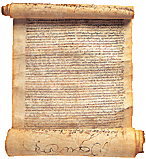 |
|
 |
The Church and monasticism: the economic situation
 uring the late Byzantine period, a time of social unrest and economic decline as well as of ever-increasing danger, since external enemies never ceased to threaten the state, the Church constituted a constant refuge and a secure haven. uring the late Byzantine period, a time of social unrest and economic decline as well as of ever-increasing danger, since external enemies never ceased to threaten the state, the Church constituted a constant refuge and a secure haven.
It
is characteristic that members of the Byzantine imperial family, more frequently than ever before, sought refuge in monasteries or became monks at the end of their lives. Moreover, the emperors frequently tried to win the favour of monasteries by granting them privileges and other gifts. It very often happened that entire villages, with their lands, inhabitants and the taxes the lands brought in were ceded to the monasteries. Private citizens, too, made donations to the monasteries, a token of their devotion and a proof of the increased influence of monasticism on Byzantine society.
 The result was that the monasteries became an important economic power, possessing a huge fortune. The result was that the monasteries became an important economic power, possessing a huge fortune.
The Church came to be the richest
landowner in late Byzantine society. Within the Church, however, there were several gradations, especially among the small monasteries and the churches that owned small areas of land, on the one hand, and the large monasteries possessing huge estates, on the other. The Church might thus be classified among the aristocracy, not only because many monasteries were counted among the great landowners, but also because the interests of the clergy and of the aristocracy were to a certain extent identical.
|